TOPIC 12. STAFF EVALUATION 12.1. Business evaluation of

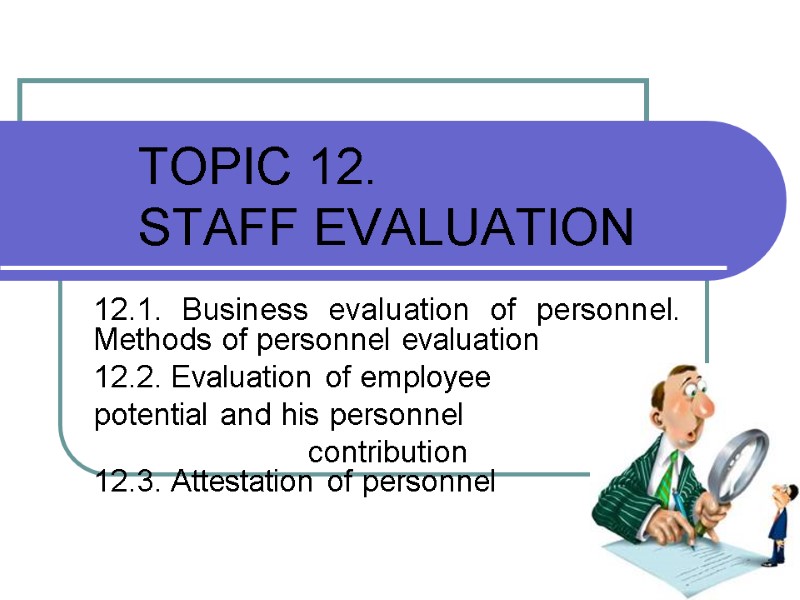
TOPIC 12. STAFF EVALUATION 12.1. Business evaluation of personnel. Methods of personnel evaluation 12.2. Evaluation of employee potential and his personnel contribution 12.3. Attestation of personnel
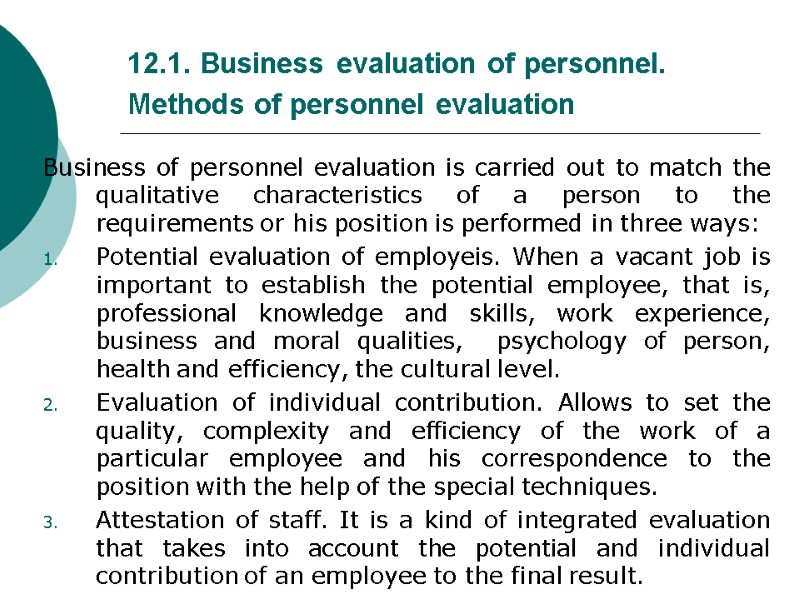
12.1. Business evaluation of personnel. Methods of personnel evaluation Business of personnel evaluation is carried out to match the qualitative characteristics of a person to the requirements or his position is performed in three ways: Potential evaluation of employeis. When a vacant job is important to establish the potential employee, that is, professional knowledge and skills, work experience, business and moral qualities, psychology of person, health and efficiency, the cultural level. Evaluation of individual contribution. Allows to set the quality, complexity and efficiency of the work of a particular employee and his correspondence to the position with the help of the special techniques. Attestation of staff. It is a kind of integrated evaluation that takes into account the potential and individual contribution of an employee to the final result.
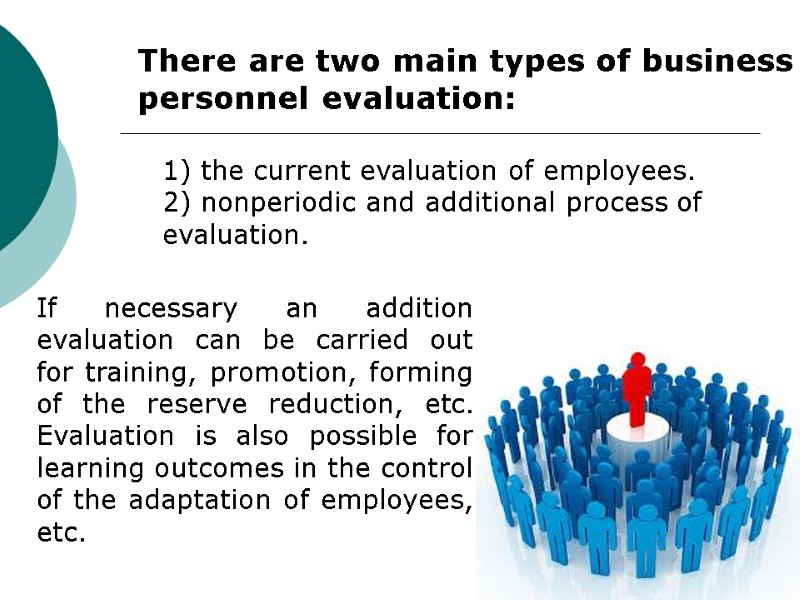
1) the current evaluation of employees. 2) nonperiodic and additional process of evaluation. There are two main types of business personnel evaluation: If necessary an addition evaluation can be carried out for training, promotion, forming of the reserve reduction, etc. Evaluation is also possible for learning outcomes in the control of the adaptation of employees, etc.
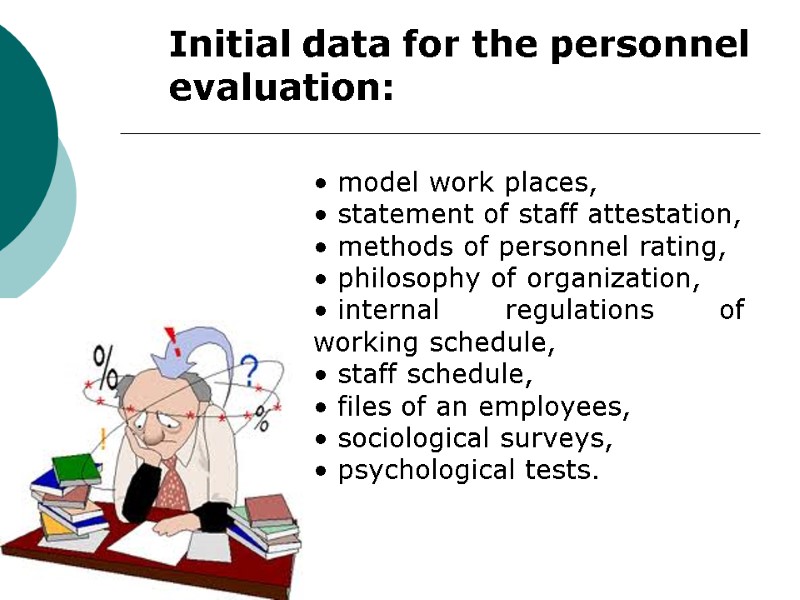
Initial data for the personnel evaluation: model work places, statement of staff attestation, methods of personnel rating, philosophy of organization, internal regulations of working schedule, staff schedule, files of an employees, sociological surveys, psychological tests.
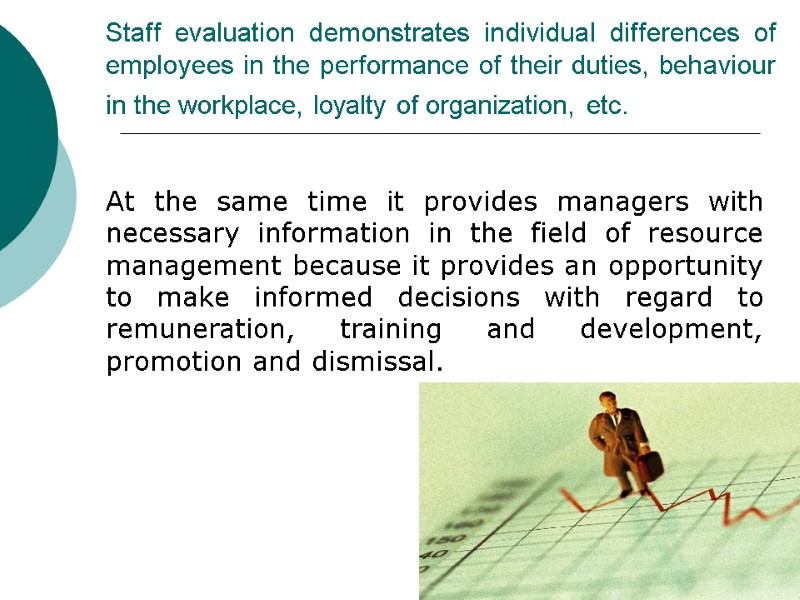
Staff evaluation demonstrates individual differences of employees in the performance of their duties, behaviour in the workplace, loyalty of organization, etc. At the same time it provides managers with necessary information in the field of resource management because it provides an opportunity to make informed decisions with regard to remuneration, training and development, promotion and dismissal.
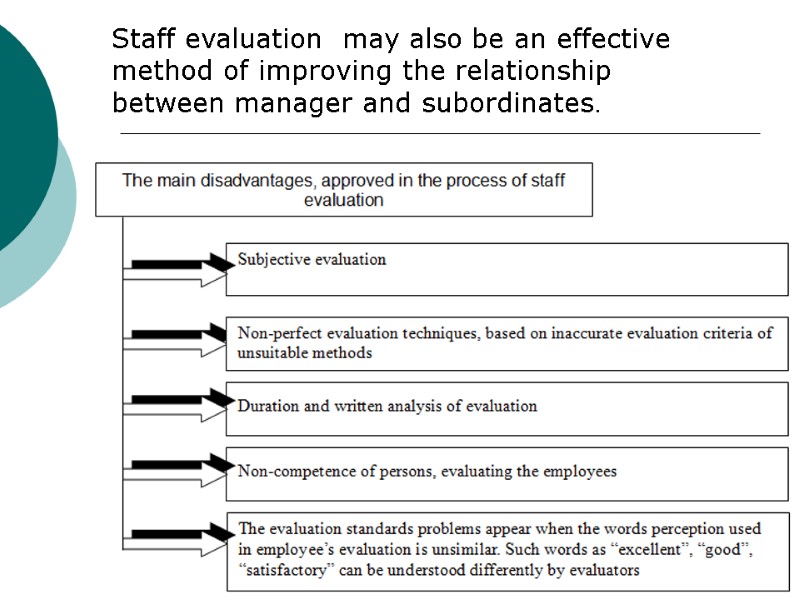
Staff evaluation may also be an effective method of improving the relationship between manager and subordinates.
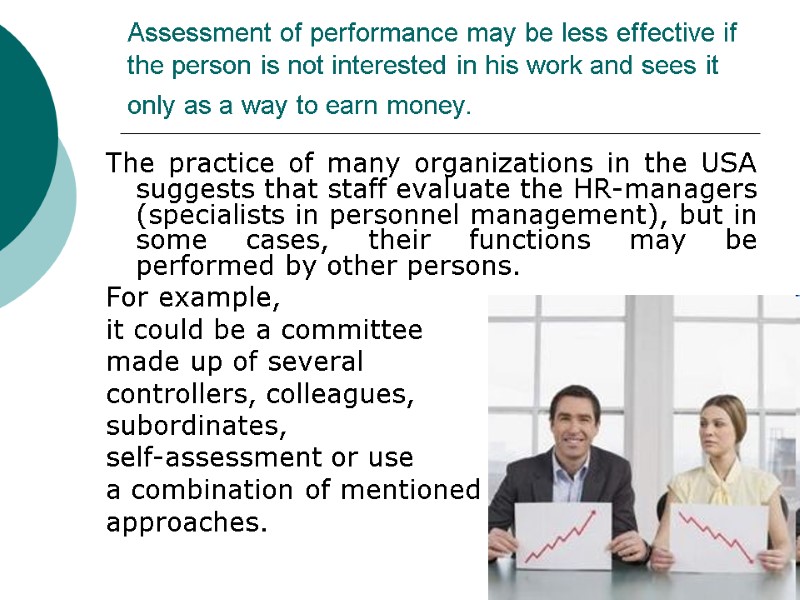
Assessment of performance may be less effective if the person is not interested in his work and sees it only as a way to earn money. The practice of many organizations in the USA suggests that staff evaluate the HR-managers (specialists in personnel management), but in some cases, their functions may be performed by other persons. For example, it could be a committee made up of several controllers, colleagues, subordinates, self-assessment or use a combination of mentioned approaches.
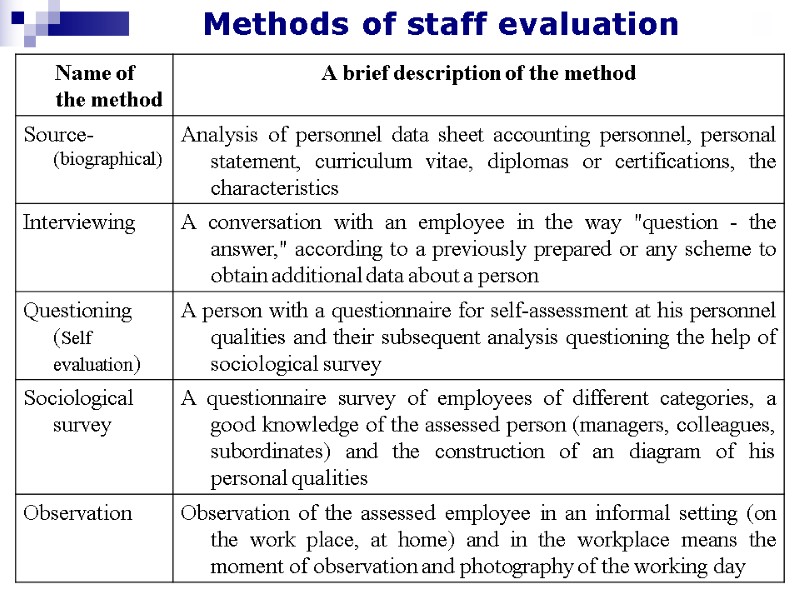
Methods of staff evaluation
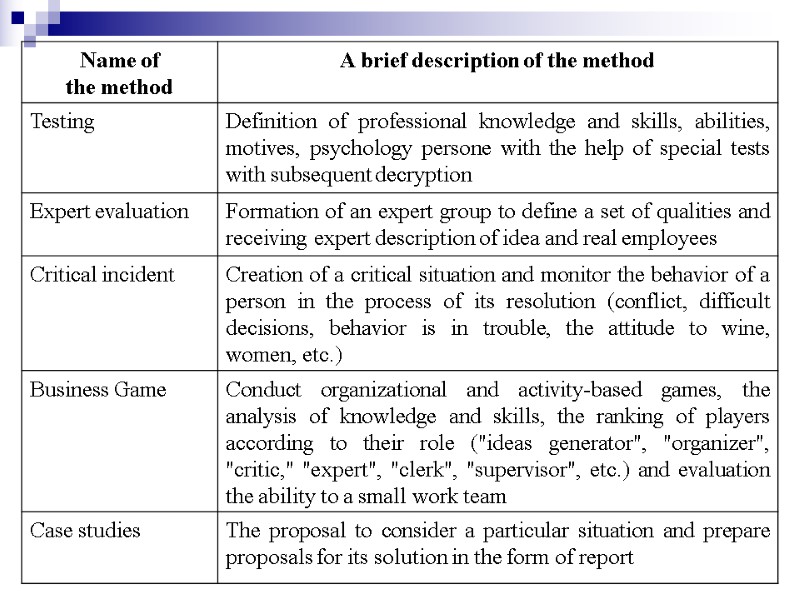
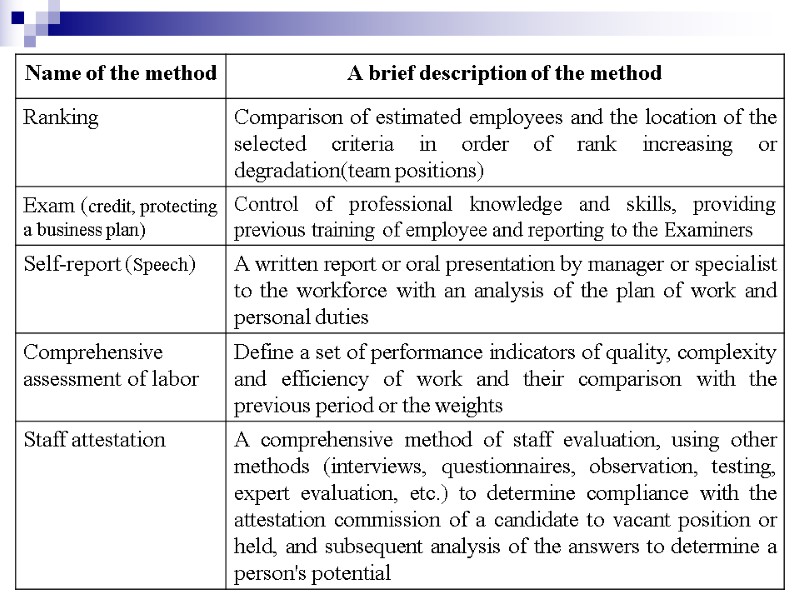
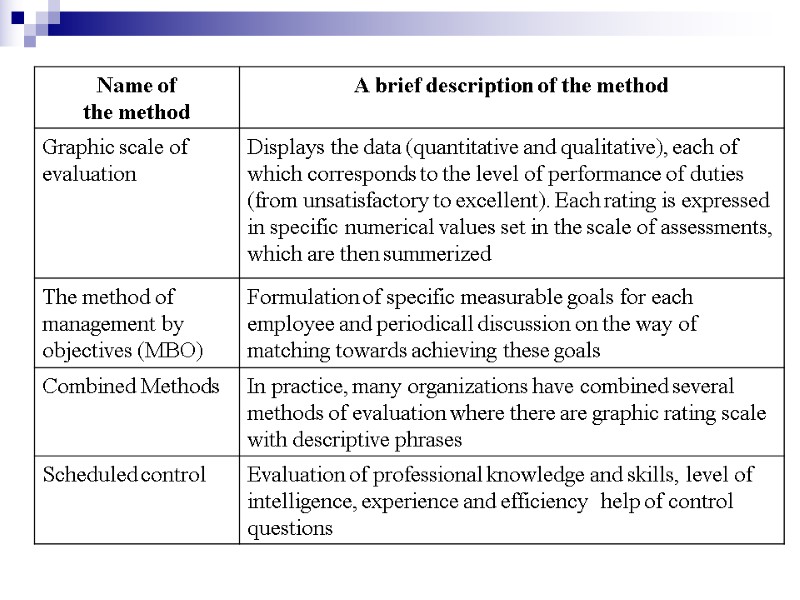
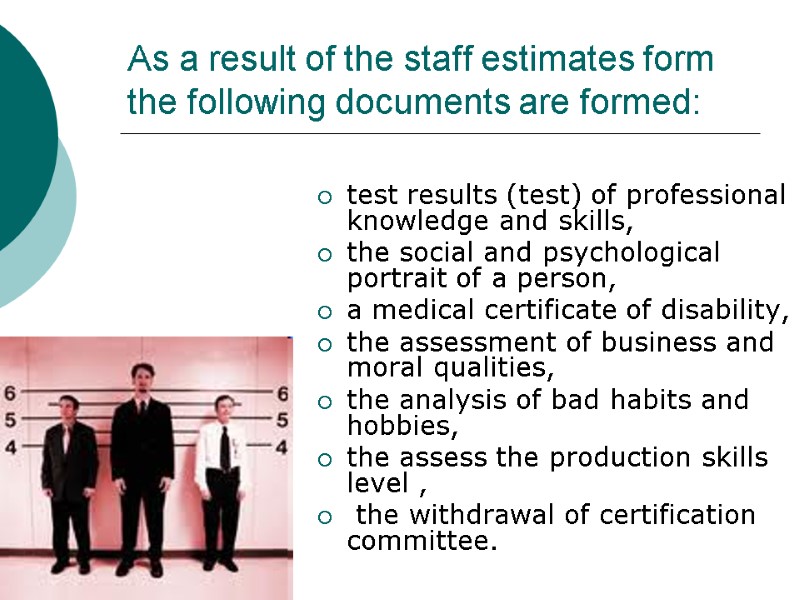
As a result of the staff estimates form the following documents are formed: test results (test) of professional knowledge and skills, the social and psychological portrait of a person, a medical certificate of disability, the assessment of business and moral qualities, the analysis of bad habits and hobbies, the assess the production skills level , the withdrawal of certification committee.
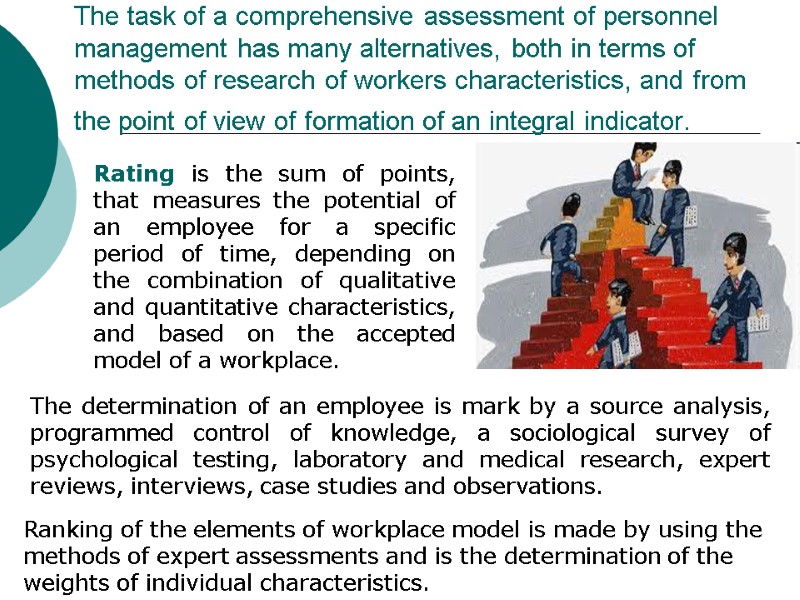
The task of a comprehensive assessment of personnel management has many alternatives, both in terms of methods of research of workers characteristics, and from the point of view of formation of an integral indicator. Rating is the sum of points, that measures the potential of an employee for a specific period of time, depending on the combination of qualitative and quantitative characteristics, and based on the accepted model of a workplace. The determination of an employee is mark by a source analysis, programmed control of knowledge, a sociological survey of psychological testing, laboratory and medical research, expert reviews, interviews, case studies and observations. Ranking of the elements of workplace model is made by using the methods of expert assessments and is the determination of the weights of individual characteristics.
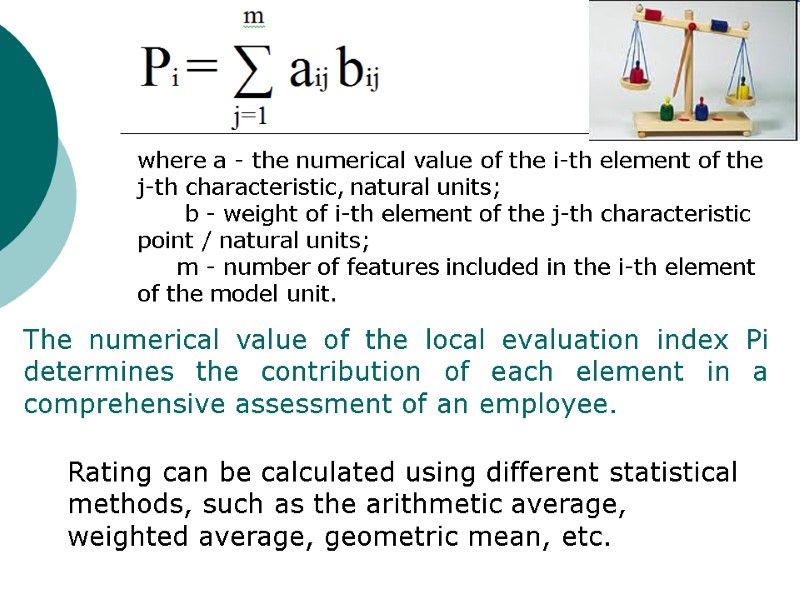
where a - the numerical value of the i-th element of the j-th characteristic, natural units; b - weight of i-th element of the j-th characteristic point / natural units; m - number of features included in the i-th element of the model unit. The numerical value of the local evaluation index Pi determines the contribution of each element in a comprehensive assessment of an employee. Rating can be calculated using different statistical methods, such as the arithmetic average, weighted average, geometric mean, etc.
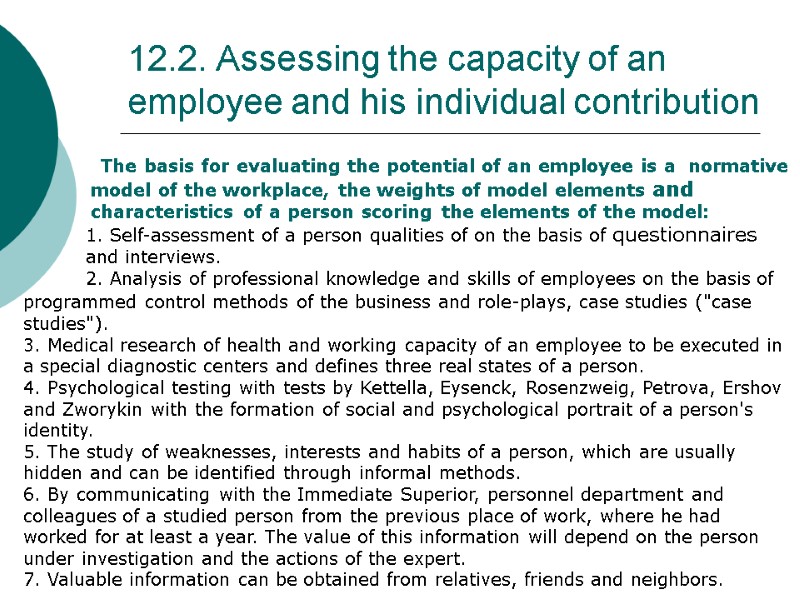
12.2. Assessing the capacity of an employee and his individual contribution The basis for evaluating the potential of an employee is a normative model of the workplace, the weights of model elements and characteristics of a person scoring the elements of the model: 1. Self-assessment of a person qualities of on the basis of questionnaires and interviews. 2. Analysis of professional knowledge and skills of employees on the basis of programmed control methods of the business and role-plays, case studies ("case studies"). 3. Medical research of health and working capacity of an employee to be executed in a special diagnostic centers and defines three real states of a person. 4. Psychological testing with tests by Kettella, Eysenck, Rosenzweig, Petrova, Ershov and Zworykin with the formation of social and psychological portrait of a person's identity. 5. The study of weaknesses, interests and habits of a person, which are usually hidden and can be identified through informal methods. 6. By communicating with the Immediate Superior, personnel department and colleagues of a studied person from the previous place of work, where he had worked for at least a year. The value of this information will depend on the person under investigation and the actions of the expert. 7. Valuable information can be obtained from relatives, friends and neighbors.
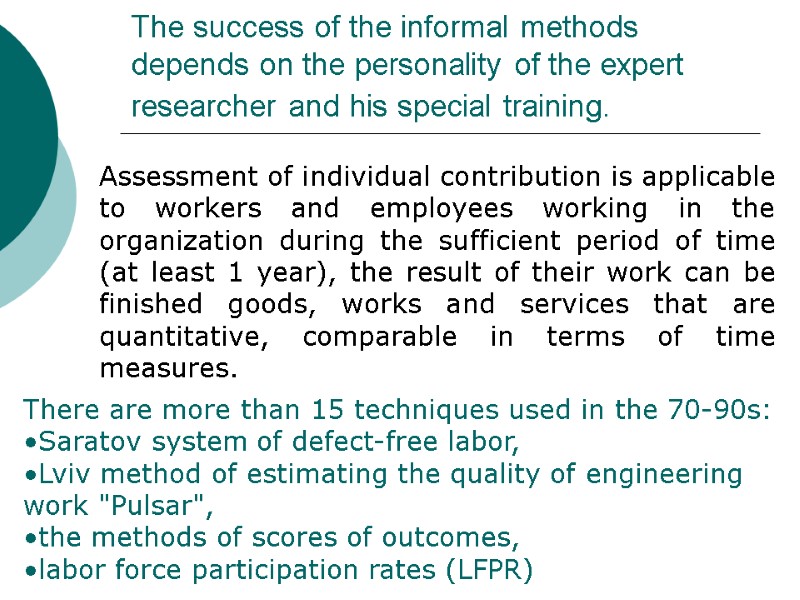
The success of the informal methods depends on the personality of the expert researcher and his special training. Assessment of individual contribution is applicable to workers and employees working in the organization during the sufficient period of time (at least 1 year), the result of their work can be finished goods, works and services that are quantitative, comparable in terms of time measures. There are more than 15 techniques used in the 70-90s: Saratov system of defect-free labor, Lviv method of estimating the quality of engineering work "Pulsar", the methods of scores of outcomes, labor force participation rates (LFPR)
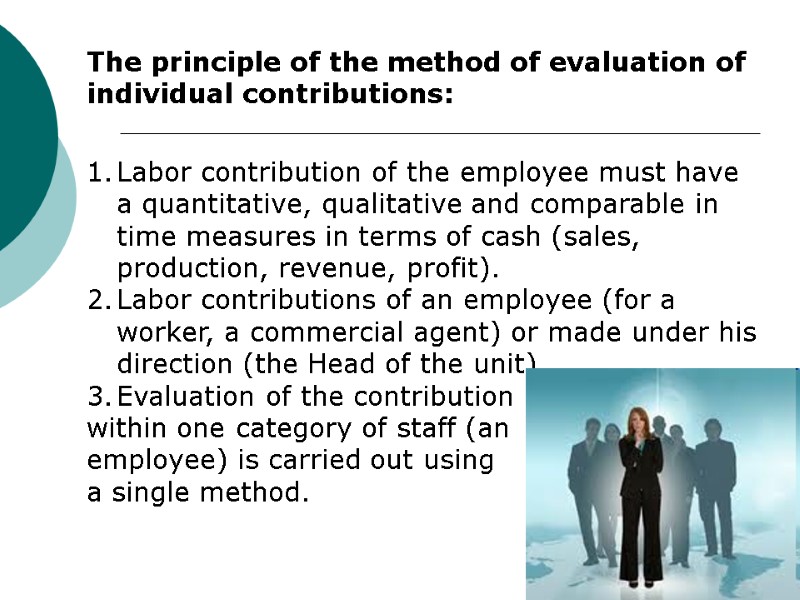
Labor contribution of the employee must have a quantitative, qualitative and comparable in time measures in terms of cash (sales, production, revenue, profit). Labor contributions of an employee (for a worker, a commercial agent) or made under his direction (the Head of the unit). Evaluation of the contribution within one category of staff (an employee) is carried out using a single method. The principle of the method of evaluation of individual contributions:
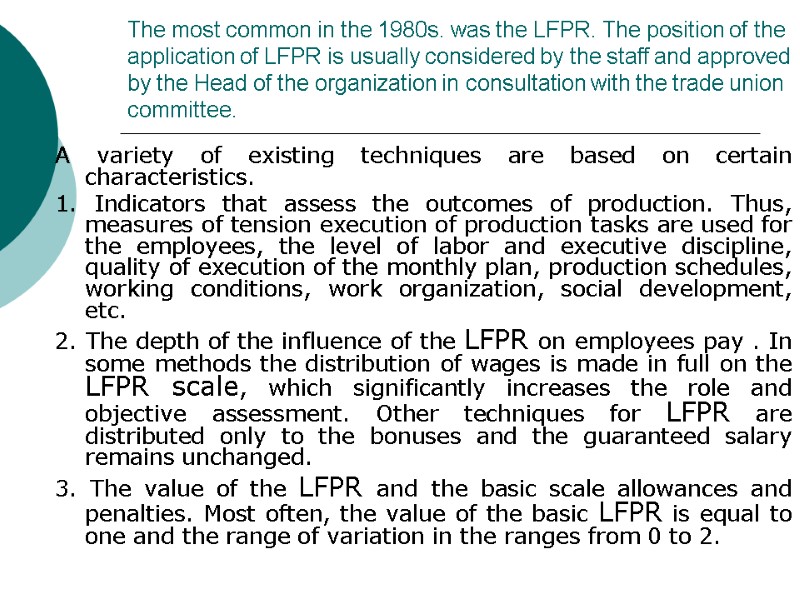
The most common in the 1980s. was the LFPR. The position of the application of LFPR is usually considered by the staff and approved by the Head of the organization in consultation with the trade union committee. A variety of existing techniques are based on certain characteristics. 1. Indicators that assess the outcomes of production. Thus, measures of tension execution of production tasks are used for the employees, the level of labor and executive discipline, quality of execution of the monthly plan, production schedules, working conditions, work organization, social development, etc. 2. The depth of the influence of the LFPR on employees pay . In some methods the distribution of wages is made in full on the LFPR scale, which significantly increases the role and objective assessment. Other techniques for LFPR are distributed only to the bonuses and the guaranteed salary remains unchanged. 3. The value of the LFPR and the basic scale allowances and penalties. Most often, the value of the basic LFPR is equal to one and the range of variation in the ranges from 0 to 2.
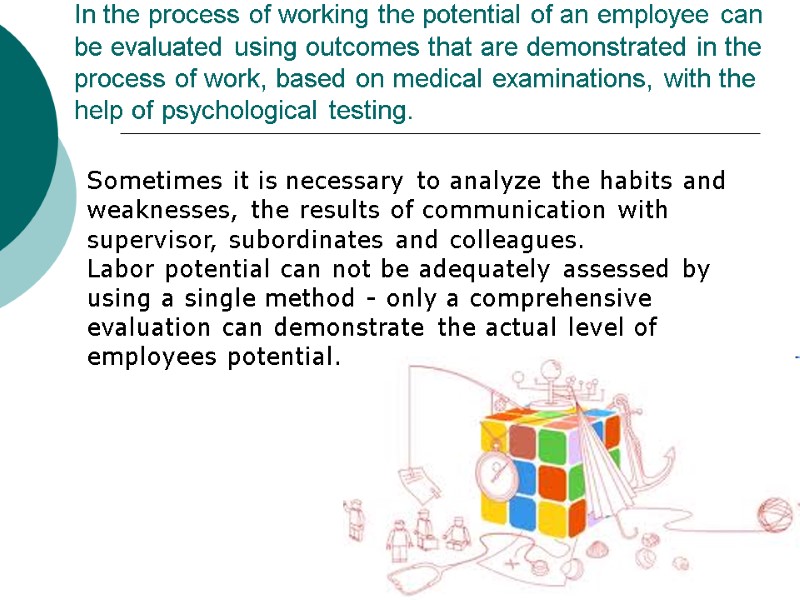
In the process of working the potential of an employee can be evaluated using outcomes that are demonstrated in the process of work, based on medical examinations, with the help of psychological testing. Sometimes it is necessary to analyze the habits and weaknesses, the results of communication with supervisor, subordinates and colleagues. Labor potential can not be adequately assessed by using a single method - only a comprehensive evaluation can demonstrate the actual level of employees potential.
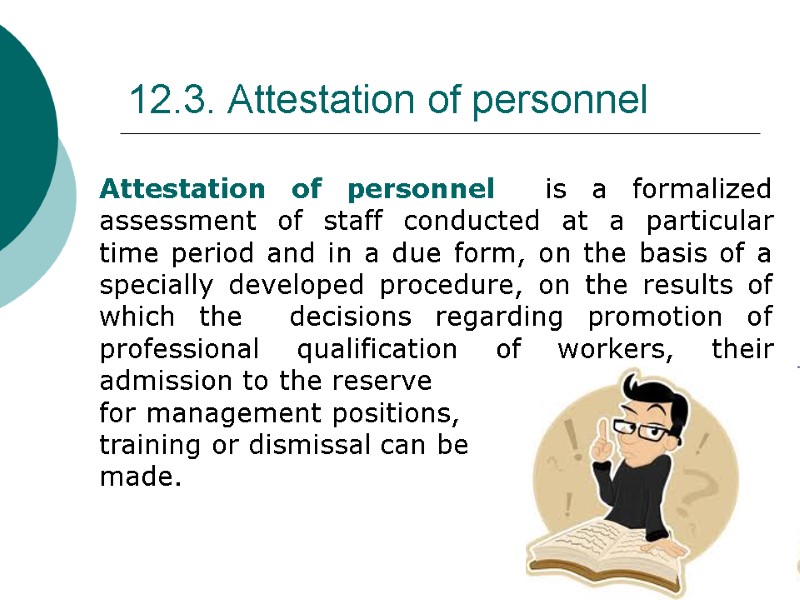
12.3. Attestation of personnel Attestation of personnel is a formalized assessment of staff conducted at a particular time period and in a due form, on the basis of a specially developed procedure, on the results of which the decisions regarding promotion of professional qualification of workers, their admission to the reserve for management positions, training or dismissal can be made.
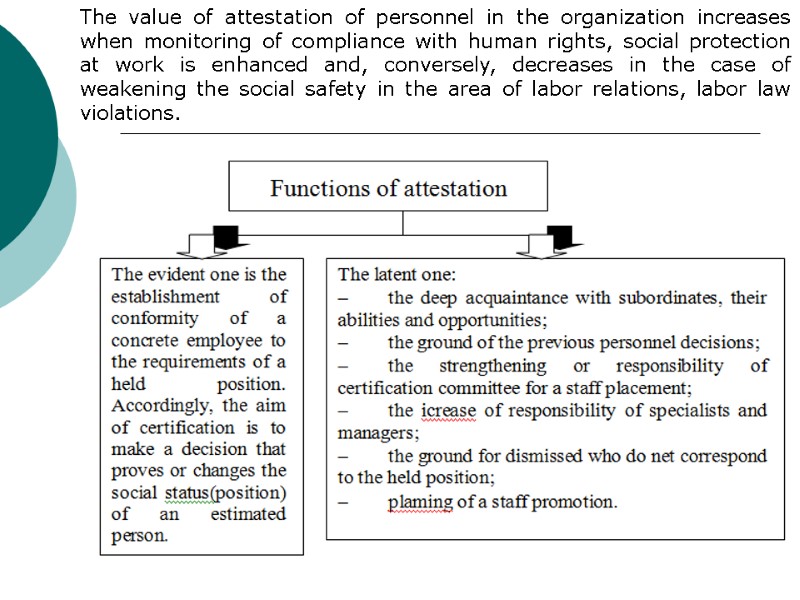
The value of attestation of personnel in the organization increases when monitoring of compliance with human rights, social protection at work is enhanced and, conversely, decreases in the case of weakening the social safety in the area of labor relations, labor law violations.
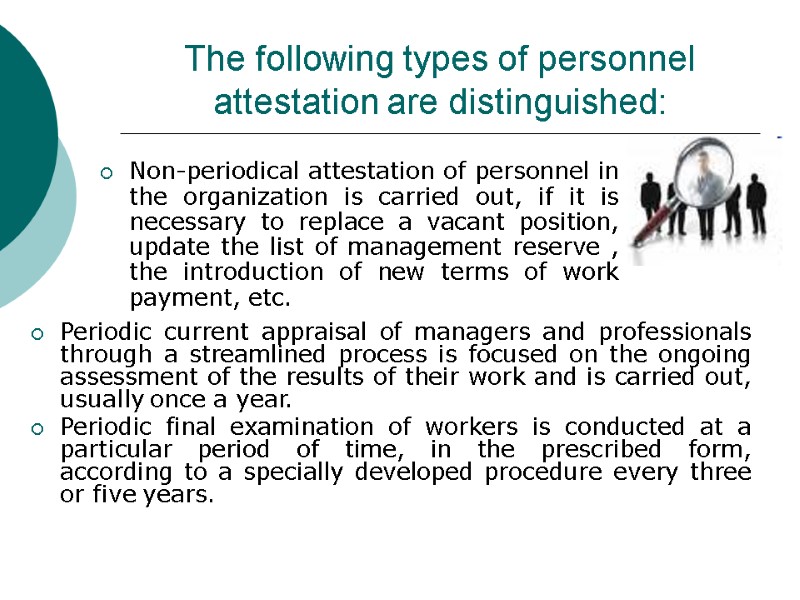
The following types of personnel attestation are distinguished: Non-periodical attestation of personnel in the organization is carried out, if it is necessary to replace a vacant position, update the list of management reserve , the introduction of new terms of work payment, etc. Periodic current appraisal of managers and professionals through a streamlined process is focused on the ongoing assessment of the results of their work and is carried out, usually once a year. Periodic final examination of workers is conducted at a particular period of time, in the prescribed form, according to a specially developed procedure every three or five years.
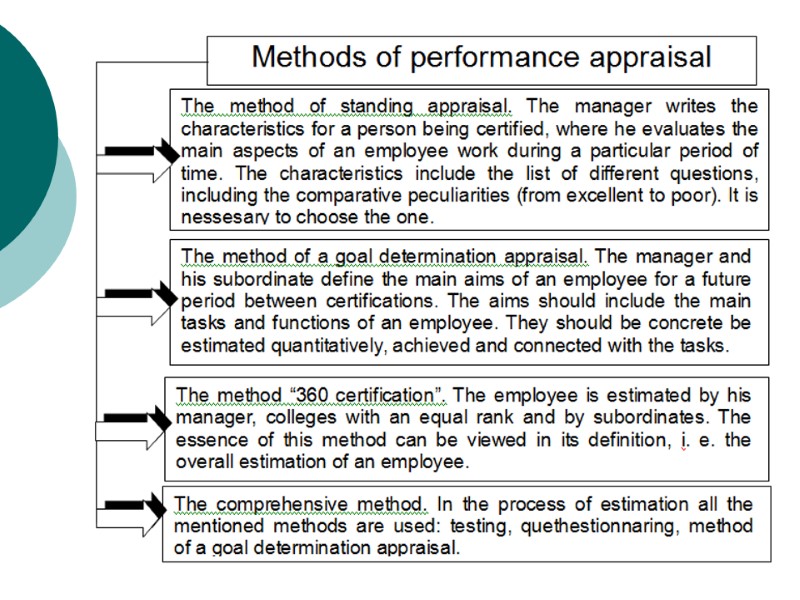
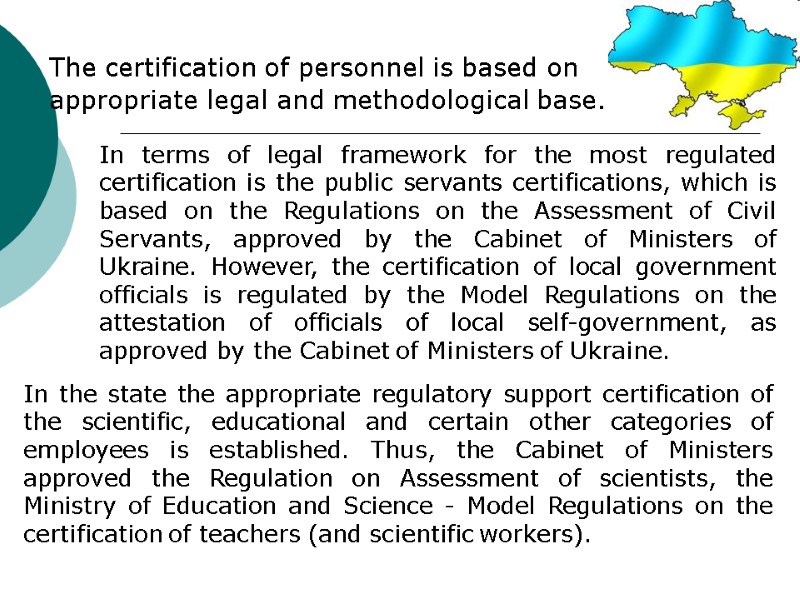
In terms of legal framework for the most regulated certification is the public servants certifications, which is based on the Regulations on the Assessment of Civil Servants, approved by the Cabinet of Ministers of Ukraine. However, the certification of local government officials is regulated by the Model Regulations on the attestation of officials of local self-government, as approved by the Cabinet of Ministers of Ukraine. The certification of personnel is based on appropriate legal and methodological base. In the state the appropriate regulatory support certification of the scientific, educational and certain other categories of employees is established. Thus, the Cabinet of Ministers approved the Regulation on Assessment of scientists, the Ministry of Education and Science - Model Regulations on the certification of teachers (and scientific workers).
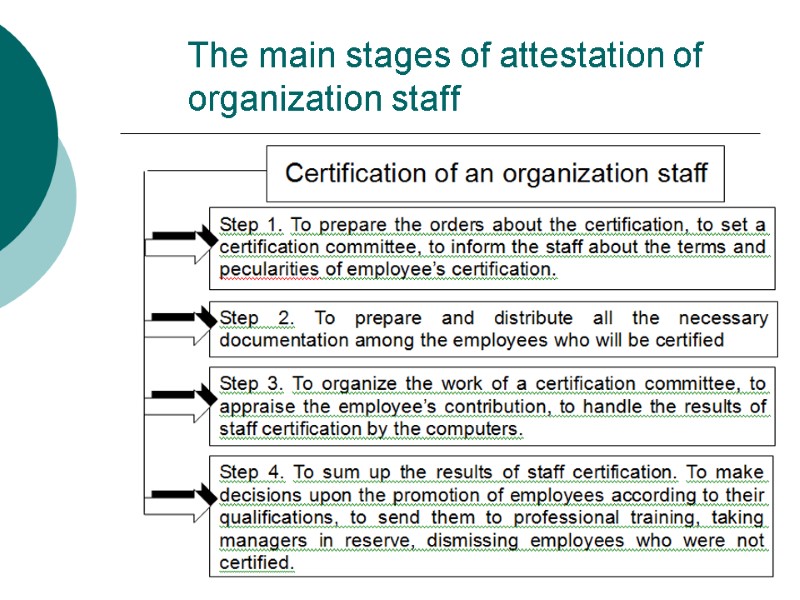
The main stages of attestation of organization staff
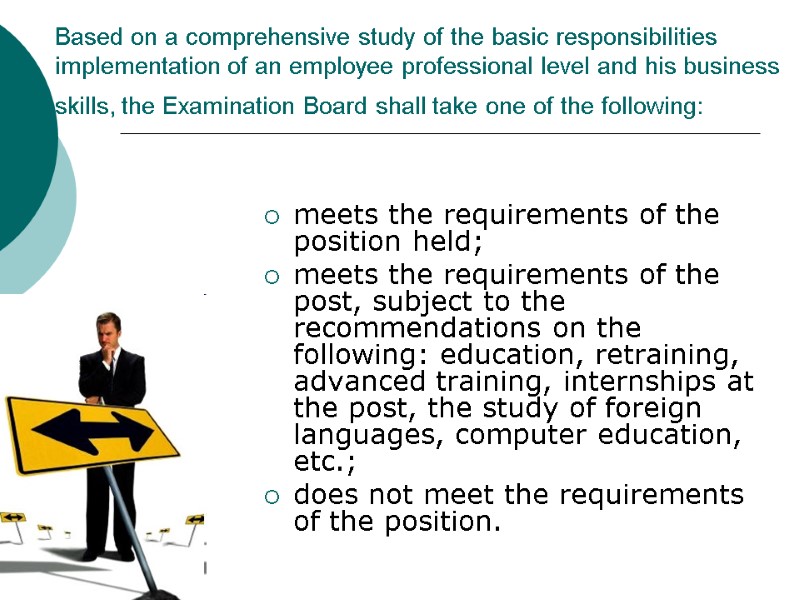
Based on a comprehensive study of the basic responsibilities implementation of an employee professional level and his business skills, the Examination Board shall take one of the following: meets the requirements of the position held; meets the requirements of the post, subject to the recommendations on the following: education, retraining, advanced training, internships at the post, the study of foreign languages, computer education, etc.; does not meet the requirements of the position.
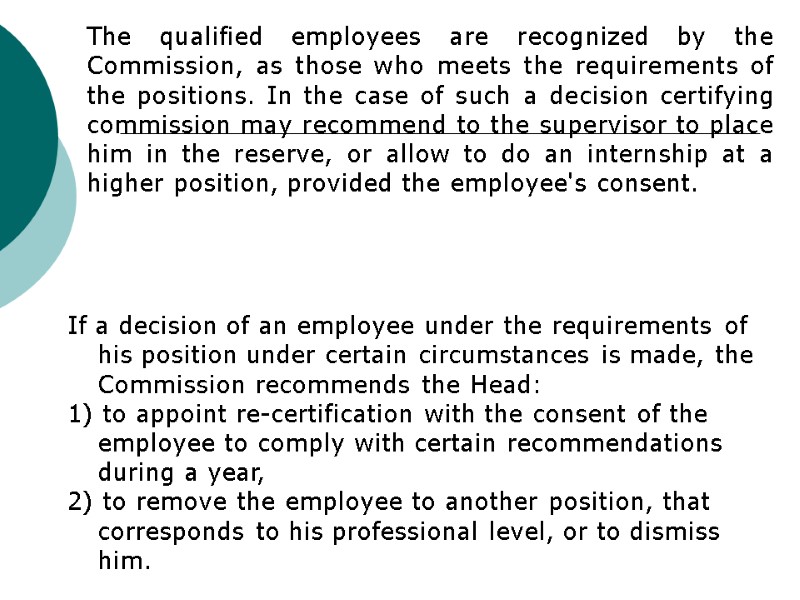
The qualified employees are recognized by the Commission, as those who meets the requirements of the positions. In the case of such a decision certifying commission may recommend to the supervisor to place him in the reserve, or allow to do an internship at a higher position, provided the employee's consent. If a decision of an employee under the requirements of his position under certain circumstances is made, the Commission recommends the Head: 1) to appoint re-certification with the consent of the employee to comply with certain recommendations during a year, 2) to remove the employee to another position, that corresponds to his professional level, or to dismiss him.
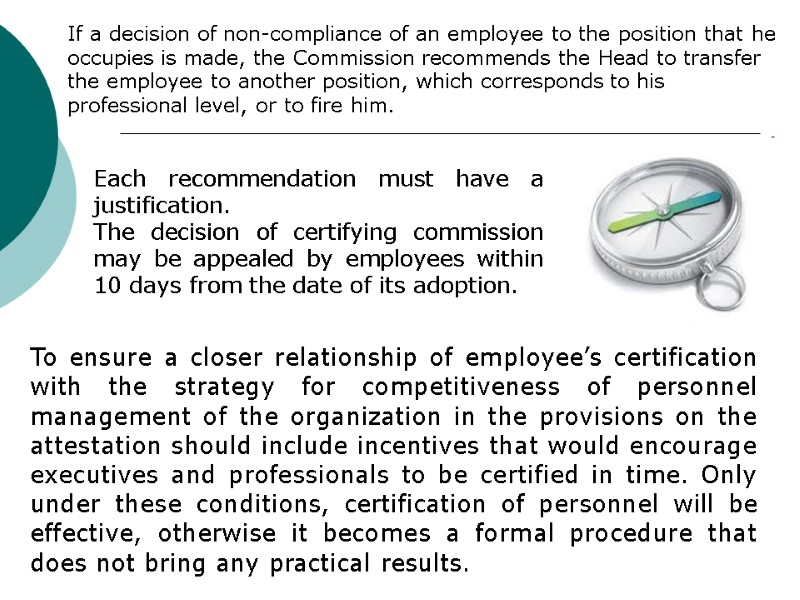
Each recommendation must have a justification. The decision of certifying commission may be appealed by employees within 10 days from the date of its adoption. If a decision of non-compliance of an employee to the position that he occupies is made, the Commission recommends the Head to transfer the employee to another position, which corresponds to his professional level, or to fire him. To ensure a closer relationship of employee’s certification with the strategy for competitiveness of personnel management of the organization in the provisions on the attestation should include incentives that would encourage executives and professionals to be certified in time. Only under these conditions, certification of personnel will be effective, otherwise it becomes a formal procedure that does not bring any practical results.

14292-topic_12._staff_evaluation.ppt
- Количество слайдов: 29

